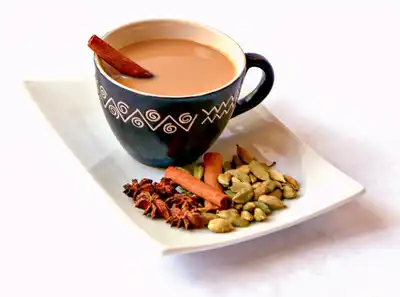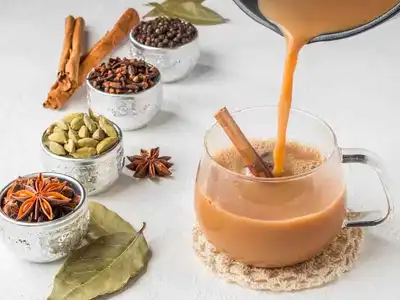
Introduction
Chai, a spiced tea that has become a beloved beverage worldwide, is known for its rich, aromatic flavor that offers a warming and comforting experience. Whether enjoyed in its traditional form or as a modern chai latte, chai has a unique taste that leaves many people wondering, what does chai taste like? In this article, we’ll explore the distinct flavors that define chai, the variations in taste across different regions, and how it compares to other popular teas. By the end, you’ll have a full understanding of what makes chai such a special and versatile drink.
Tell Me What Does Chai Taste Like?
To answer what does chai taste like, it’s essential to break down the key components that contribute to its distinctive flavor. Chai is more than just a tea—it’s a blend of spices, tea leaves, and often, milk and sweeteners, all working together to create a complex and satisfying drink.
The Spice Blend
The most defining characteristic of chai is its spice blend, which gives it its warm and aromatic flavor. While the exact combination of spices can vary depending on the recipe, the following are the most commonly used:
- Cinnamon: Adds warmth and sweetness to chai, creating a comforting base note that’s instantly recognizable.
- Cardamom: This spice contributes a fragrant, slightly sweet, and floral note, giving chai its distinctive aroma and a hint of citrus-like sharpness.
- Ginger: Known for its spicy, peppery kick, ginger adds a touch of heat to chai, making it more invigorating and lively.
- Cloves: Cloves provide a deep, aromatic, and slightly bitter flavor, adding complexity and a bit of intensity to the chai.
- Black Pepper: Often used sparingly, black pepper enhances the overall spiciness, adding a subtle sharpness that complements the sweetness and warmth of the other spices.
These spices work together in harmony, creating a balanced, warming, and slightly spicy flavor profile that is both rich and comforting. The combination of these spices is what sets chai apart from other teas, making it a unique and flavorful beverage.
The Role of Tea and Sweetness
The base of chai is typically black tea, which adds a robust and slightly bitter undertone to the drink. The strength of the tea can vary, but it usually provides a solid backbone that supports the spices. The bitterness of the black tea is balanced by the addition of sweeteners, such as sugar, honey, or other natural sweeteners, which help to mellow out the spices and create a smooth, well-rounded flavor.
The level of sweetness in chai can vary depending on personal preference and regional variations. In traditional Indian chai, sugar is often added generously, resulting in a sweet and spicy beverage. In contrast, Western versions of chai may be less sweet, especially when prepared as a chai latte, which is often served with steamed milk and a touch of sweetener.
The combination of spices, black tea, and sweetness results in a drink that is rich, flavorful, and deeply satisfying, making chai a beloved beverage for many.

How Chai’s Flavor Can Vary
While the core components of chai remain consistent, the flavor of chai can vary significantly depending on how it’s prepared and where it’s made. These variations allow chai to cater to a wide range of tastes, making it a versatile drink that can be customized to suit different preferences.
Regional and Cultural Differences
What does chai taste like can differ greatly depending on the region and cultural practices involved in its preparation. In India, chai is typically robust, heavily spiced, and sweetened generously. The spices used are often fresher, and the tea is brewed longer, resulting in a stronger, more intense flavor. Indian chai is also traditionally prepared with whole milk, which adds a rich, creamy texture that complements the bold spices.
In contrast, Western adaptations of chai, such as the popular chai latte, often feature a milder spice profile. These versions focus more on creating a creamy, smooth beverage with a subtle spice flavor. The spices are usually more subdued, with an emphasis on cinnamon and vanilla, making the drink sweeter and less intense. The use of steamed milk or non-dairy alternatives also contributes to the creamier, richer taste of Western chai.
In other regions, chai might be made with variations in spices, tea strength, and sweetness levels, leading to unique flavor profiles that reflect local tastes and preferences. For example, some Middle Eastern versions of chai might include additional spices like saffron or nutmeg, adding another layer of complexity to the drink.
Milk and Non-Dairy Alternatives
Another factor that significantly affects what chai tastes like is the choice of milk or non-dairy alternatives. The type of milk used can alter the flavor and texture of the chai, providing different experiences based on the milk’s fat content and flavor profile.
- Whole Milk: Traditional chai is often made with whole milk, which adds a rich, creamy texture and a slight sweetness that enhances the overall flavor. The full fat in whole milk helps to balance the spices, making the chai taste smooth and velvety.
- Almond Milk: A popular non-dairy alternative, almond milk adds a nutty flavor to the chai. While it is less creamy than whole milk, it complements the spices well and offers a lighter, slightly sweet taste.
- Oat Milk: Known for its creamy texture and mild sweetness, oat milk is an excellent choice for those who prefer a non-dairy option that still provides a rich, full-bodied chai. It blends smoothly with the spices, creating a well-rounded flavor.
- Soy Milk: Soy milk adds a thicker texture and a subtle bean-like flavor to chai. It is often used in chai lattes for its ability to froth well, giving the chai a rich, creamy consistency.
- Coconut Milk: Coconut milk introduces a tropical twist to chai, with its creamy texture and distinctive coconut flavor. It pairs well with the spices, offering a unique and slightly exotic flavor profile.
The choice of milk or non-dairy alternatives can significantly change the taste and texture of chai, allowing for a personalized chai experience that caters to individual dietary preferences and flavor preferences.

How Does Chai Compare to Other Teas?
To fully appreciate what does chai taste like, it helps to compare it with other popular teas. Chai’s rich, spiced flavor profile sets it apart from the more subtle and delicate tastes of other tea varieties.
Chai vs. Green Tea
Green tea is renowned for its light, grassy, and slightly astringent taste, which is a stark contrast to the bold, spicy flavors of chai. Green tea has a more delicate and refreshing flavor, often enjoyed for its mild bitterness and natural sweetness. While green tea is typically consumed without milk or sweeteners, chai is often served with both, creating a richer, creamier beverage. The addition of spices in chai also makes it more complex and warming, making it a preferred choice for those who enjoy a fuller-bodied, spiced tea.
Green tea is often associated with a clean, pure taste and is appreciated for its simplicity. On the other hand, chai is celebrated for its complexity, with layers of flavor that include sweet, spicy, and earthy notes. The spices in chai, such as cinnamon, cardamom, and ginger, provide warmth and depth, offering a completely different experience from the lighter, more straightforward flavor of green tea.
Chai vs. Herbal Tea
Herbal teas, such as chamomile, peppermint, and rooibos, are typically caffeine-free and known for their gentle, soothing flavors. Unlike chai, which is made from black tea and a blend of spices, herbal teas are often made from dried fruits, flowers, or herbs, resulting in a milder and more soothing drink.
Chamomile tea, for example, has a light, floral taste that is calming and often used as a bedtime tea. Peppermint tea is refreshing with a cool, minty flavor, while rooibos has a naturally sweet, earthy flavor. These herbal teas are generally more subtle in flavor compared to chai, which is bold, spicy, and rich.
Chai’s complexity and spice make it a more invigorating and warming beverage, suitable for those who enjoy a strong, flavorful tea. Herbal teas, in contrast, offer a more delicate and relaxing experience, making them a popular choice for unwinding at the end of the day. The spiced richness of chai is a unique experience, quite different from the gentle flavors found in most herbal teas.
Conclusion
So, what does chai taste like? Chai is a delightful blend of bold spices, robust black tea, and a touch of sweetness, creating a complex and comforting beverage. Its flavor profile is rich and layered, with notes of cinnamon, cardamom, ginger, and cloves combining to produce a warm, aromatic drink. Whether you prefer it with whole milk for a creamy texture or with a non-dairy alternative for a lighter taste, chai offers a unique experience that sets it apart from other teas.
Chai’s versatility allows it to cater to a wide range of palates, whether you enjoy a strong, spicy brew in the traditional Indian style or a milder, sweeter chai latte popular in the West. Exploring the different variations of chai can help you discover the perfect balance of flavors that suits your taste.
For anyone curious about what chai tastes like, the answer lies in its rich, spiced complexity—a tea that’s both comforting and invigorating, making it a beloved choice for tea lovers around the world.